Tidwell J. Designing Interfaces (Second Edition)
Подождите немного. Документ загружается.

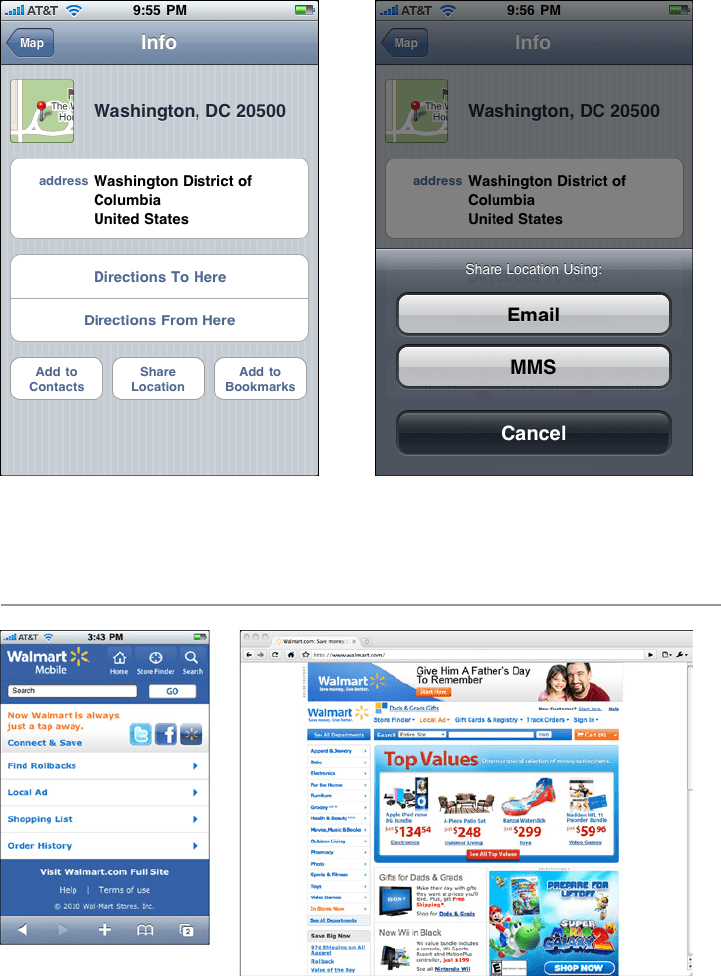
The Patterns 473
Figure 10-30.
The iPhone map application connecting to contacts, mail, and MMS
Streamlined Branding
Figure 10-31.
Walmart’s mobile site compared to its full site
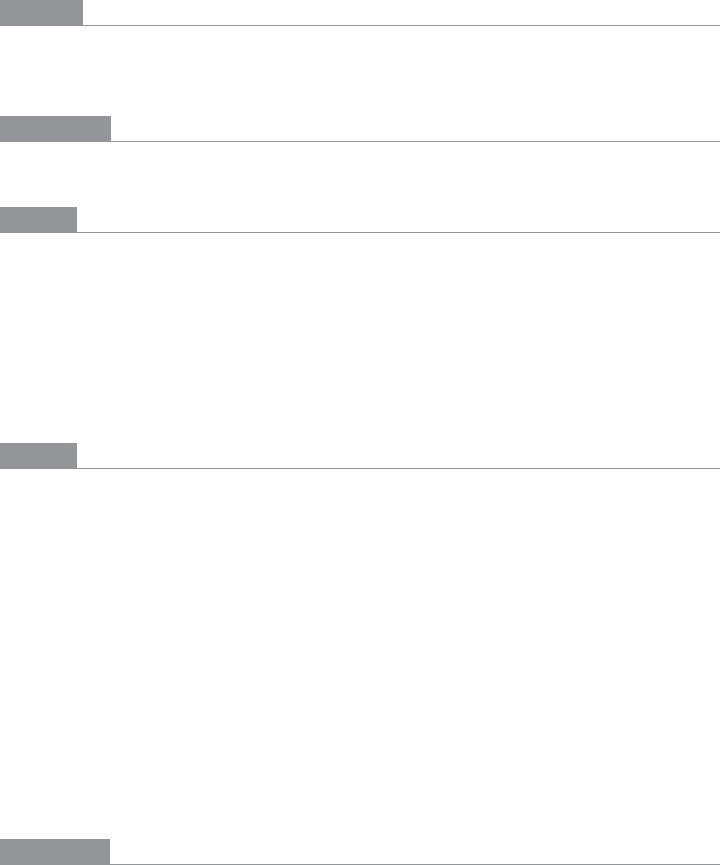
474 Chapter 10: Going Mobile
What
Use your organization’s logo, colors, and other brand elements on the mobile site or app,
but keep them small on the screen and fast to load.
Use when
All mobile apps or sites that are associated with a company or organization should use this.
Why
Users need to be able to identify your app or site as yours. In usability testing, people
respond well to reliable, familiar branding, especially when the brand is already known
outside of the mobile context.
Mobile screens don’t have much space to spare for elements that aren’t actual content.
Mobile network connections can be slow, and heavyweight images don’t download fast
enough.
How
Create a small version of your logo, no taller than around 50 pixels, so that it takes up as
little vertical space as you can get away with. If you’re creating different designs for dif-
ferent screen sizes or platforms, consider making different versions of the logo for each.
Apply your brand’s colors and font families in the mobile design. A basic text interface
may function well enough, but it won’t look professional or polished.
Avoid using very large and complex images as stylistic elements. Download time is as
important in a mobile context as on the desktop (and often more so). If you’re working in
HTML, depend on stylesheets when you can, rather than handcrafted images.
Strong contrast and large, readable text will help people use your mobile site when the
conditions are poor (bright light, motion, distraction). Even if your brand calls for visual
subtlety and small, tasteful text, do what needs to be done for the sake of usability—adapt
the brand look to the platform.
Examples
There are good examples of this pattern all over the mobile web. Going back to the first
example given in this chapter, JetBlue pares down its branding to a look that is polished
and recognizable, but works well on even a tiny mobile device (see Figure 10-32).
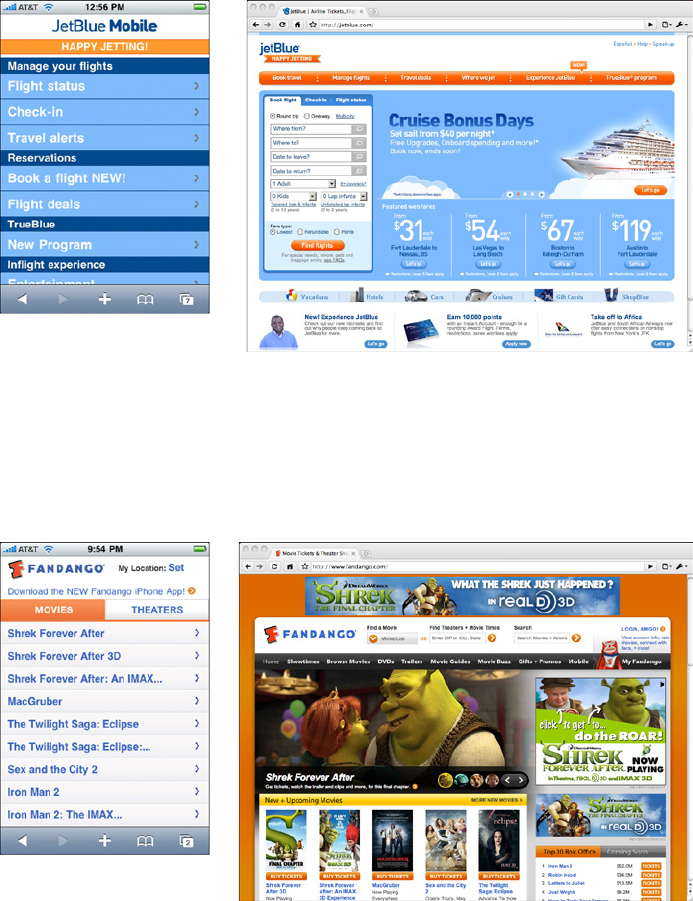
The Patterns 475
Figure 10-32.
JetBlue’s mobile branding
Fandango’s mobile site also takes a minimalist approach (see Figure 10-33). Like JetBlue,
Fandango uses a polished-looking logo and style, but the site loads fast and can be used
on tiny screens. None of the bandwidth-hogging images, ads, or video is loaded onto the
mobile device.
Figure 10-33.
Fandango’s mobile branding
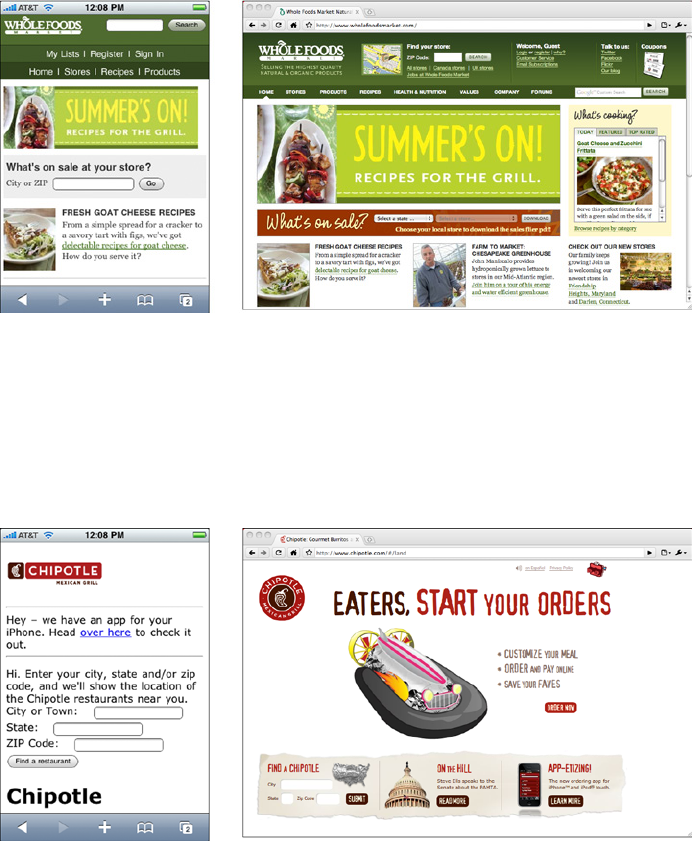
476 Chapter 10: Going Mobile
Whole Foods maintains a very consistent brand look across its full-page and mobile sites.
But its mobile site consumes more above-the-fold space than necessary with top navigation,
and it downloads several large images, making it slower than it could be (see Figure 10-34).
Figure 10-34.
Whole Foods’ mobile branding
Chipotle’s mobile website shows how not to do mobile branding (see Figure 10-35). The
brand is strong enough on the main site, but none of it shows up on the mobile site except for
a too-small version of the logo! The site uses only a neutral font and colors. (To be fair, the site
does supply an iPhone app that has stronger branding, but it’s not likely that a very occasional
customer will bother with the hassle of downloading it if the website fills her needs.)
Figure 10-35.
Chipotle’s mobile branding (or lack thereof)

Chapter 11
Making It Look Good:
Visual Style and Aesthetics
In 2002, a research group discovered something interesting. The Stanford Web Credibility
Project
*
set out to learn what causes people to trust or distrust websites, and much of what
they found made intuitive sense: company reputation, customer service, sponsorships,
and ads all helped users decide whether or not a website was credible.
But the most important factor—number one on their list—was the appearance of the
website. Users did not trust sites that looked amateurish. Sites that made the effort to craft
a nice, professionally designed look made a lot more headway with users, even if those
users had few other reasons to trust the site.
Here’s another data point. Donald Norman, one of the best-known gurus of interaction
design, concluded that “positive affect enhances creative, breadth-first thinking whereas
negative affect focuses cognition, enhancing depth-first processing and minimizing dis-
tractions.” He added: “Positive affect makes people more tolerant of minor difficulties and
more flexible and creative in finding solutions.”
†
Interfaces actually become more usable
when people enjoy using them.
Looking good matters.
For many chapters now, we’ve talked about the structure, form, and behavior of an appli-
cation; now we’ll focus more on its “skin” or its “look-and-feel.” Chapter 4 discussed some
graphic design basics. That chapter covered visual hierarchy, visual flow, focal points, and
the Gestalt principles of proximity, similarity, continuity, and closure. These topics form
the foundation of page organization, and should not be shortchanged.
* See http://credibility.stanford.edu.
† See Donald Norman, “Emotion and Design: Attractive Things Work Better,” at http://jnd.org/dn.mss/emo-
tion_design_attractive_things_work_better.html. See also his book on the subject, Emotional Design: Why We
Love (or Hate) Everyday Things (Basic Books).
478 Chapter 11: Making It Look Good: Visual Style and Aesthetics
But there’s more to a nice house than just its room layout. When you pay for a well-
designed new house, you also expect beautiful carpets, paint colors, wall textures, and
other surface treatments. Without them, a house can be perfectly functional but uninspir-
ing. Completing the job means paying attention to detail, fit, and finish.
Beautiful details don’t necessarily affect the efficiency with which people accomplish tasks
in the house or interface (although research indicates that it sometimes does). But they
certainly affect whether or not people enjoy it. That, in turn, affects other behavior—such
as how long users linger and explore, whether they choose to go there again, and whether
they recommend it to other people.
You could even think about it as a moral issue. What kind of experience do you want
your users to have? Do you want to give them an all-gray application that bores them, or
a flashy ad-filled application that irritates them? Would you rather give them something
they enjoy looking at, maybe for hours at a time?
Of course, far more than visual style influences a user’s emotional response (affect).
Chapter 1 began discussing other considerations, such as how well you anticipate users’
usage habits. Software can pleasantly surprise people with considerate design. Tightly
packed layouts evoke a different affective response than sparse, open layouts. Language
and verbal tone play a huge part in this response, as does the quality of the software
itself—does it “just work,” and is it fast and responsive?
A well-designed interface takes all of these factors into account. When content, meaning,
and interactive behavior all work in concert with your visual style, you can evoke a chosen
emotional response very effectively.
With products and websites, stylistic elements are often designed to support branding.
The design of any software product or site expresses something about the organization
that produced it (even if it’s a loosely knit group of open source developers). It might say
something neutral, or it might send a focused message: “You can trust us,” “We’re cool,”
“We build exciting things.” A brand identity encompasses more than just a logo and tag
line. It runs throughout an organization’s product designs, its website, and its advertising
materials—in fact, the brand’s chosen color schemes, fonts, iconography, and vocabu-
lary show up everywhere. When planned well, a complete brand identity is coherent and
intentional.
Same Content, Different Styles 479
A brand identity is important because it establishes familiarity and sets expectations for
someone’s experience with an organization’s products. Ultimately, a good brand should
make people feel better about using those products. Look at what Apple was able to do
with brand loyalty: many people love Apple products and seek them out.
In any case, whether or not they are intended to support a brand, stylistic elements make
statements about your product. They communicate attributes such as reliability, excite-
ment, playfulness, energy, calmness, strength, tension, and joy. What do you want to
communicate?
This chapter discusses more visual design concepts, this time focusing less on formal
structure and more on these emotionally based attributes. The chapter won’t make an
artist out of you—that takes serious practice and study. But the patterns capture some
techniques commonly found on well-designed artifacts and explain why they work.
Same Content, Different Styles
To explore how styles evoke different visceral and emotional reactions, we can try apply-
ing different visual styles to identical content. The actual content isn’t even that impor-
tant—we’re looking for immediate, prerational reactions here, not the impressions gained
from reading and interacting with the content.
The CSS Zen Garden website (http://csszengarden.com) offers us exactly that situation.
Invented as a showcase for CSS-based web design, this site provides a single HTML page
to all participants—everyone gets the same body text, the same HTML tags, and the same
lists of links. Participants then create unique CSS files to define new visual designs for the
page, and contribute them to the site. Visitors can browse through all the contributed CSS
designs. It’s a delightful way to spend an hour or three, especially if you’re teaching your-
self about visual design and trying to understand what you do and do not like.
Figures 11-1 through 11-8 present a sample of these designs. In each case, the basic content
is the same; only the design has changed. Take some time to examine each one. When you
look at each design, what is your immediate, visceral reaction? What words come to mind
that describe the page? Does it draw you in, repel you, make you nervous, or delight you?
Do wnl oa d fr om W ow! e Bo ok < ww w.w ow eb oo k. co m>
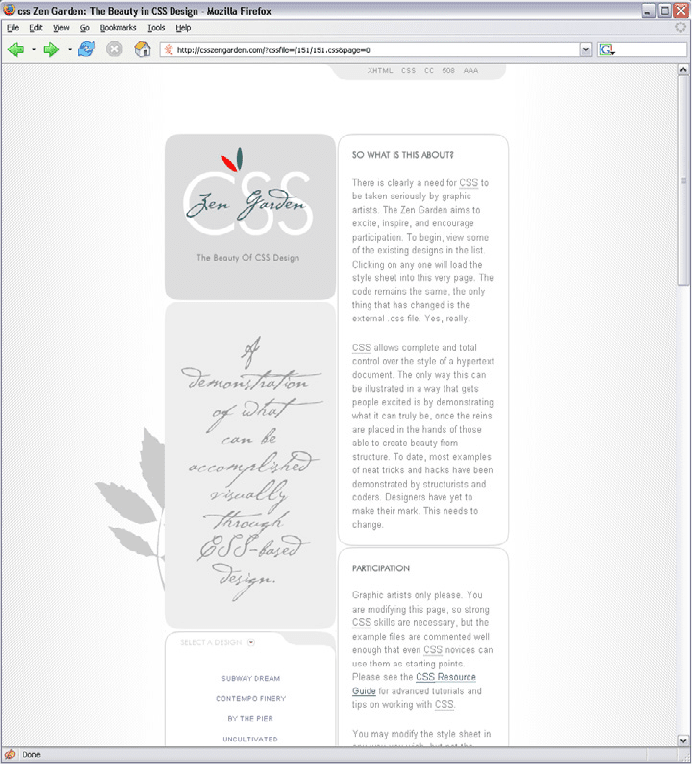
480 Chapter 11: Making It Look Good: Visual Style and Aesthetics
Figure 11-1.
Design 1
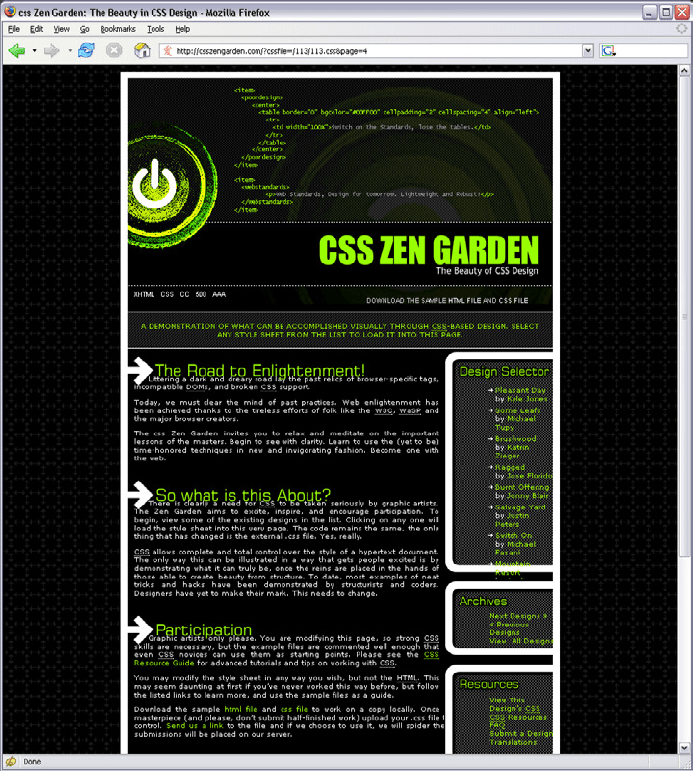
Same Content, Different Styles 481
Figure 11-2.
Design 2
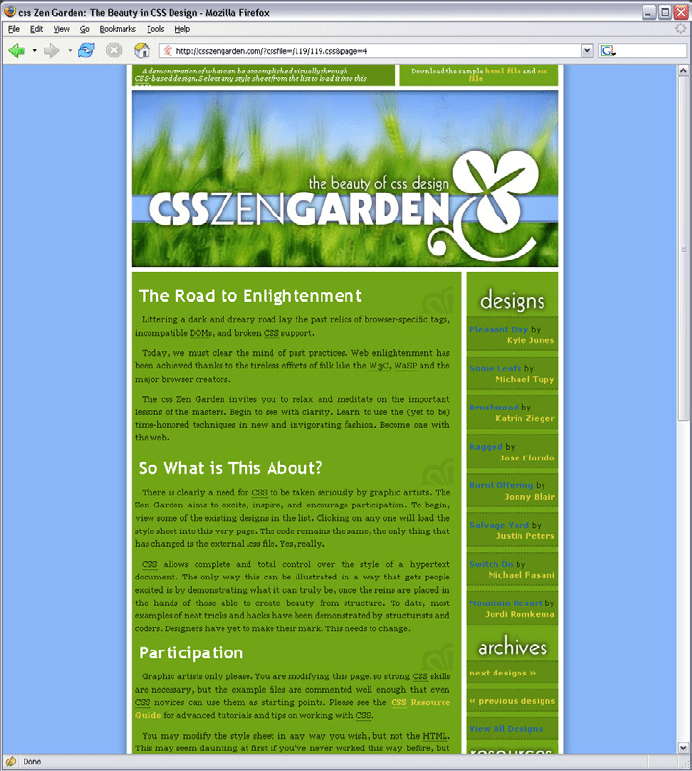
482 Chapter 11: Making It Look Good: Visual Style and Aesthetics
Figure 11-3.
Design 3
